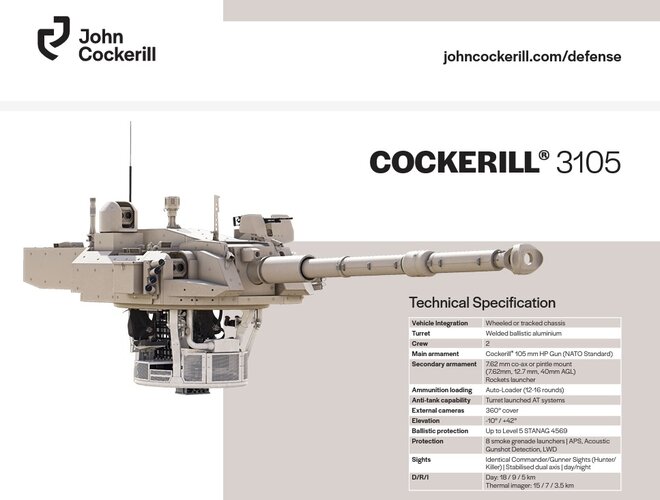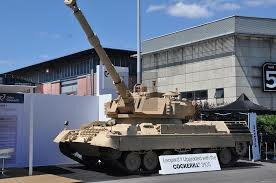Wheeled and tracked. One tracked for the heavy armor role and the other as light one.
Best case they have as mutch as possible similiar.
Ok so a medium weight wheeled chassis and a heavy tracked one. Something like a Centauro and a Abrams X?
Yes but with your "large" range of Motion you can make it small for BLOS and then switch to LOS.
I think you are referring to the propellant size and saying that it could be smaller for BLOS specific ammunition and larger for LOS. A smaller charge on a BLOS round would reduce the necessary hardening which would be useful if it has electronics in it, then regain the lost range by firing it in an arc like artillery. The lower velocity would make it less accurate, but BLOS rounds are usually guided in some way anyhow.
EFP are like Shaped charges for the most part.
Not quite, they have better behind armour damage (I love that that abbreviates to BAD), lower penetration, lose less penetrating power over distance, and often use denser tantalum instead of copper in high end ones. (Side question, but I've never heard of tantalum being used in HEAT warheads, why so - it seems like it would significantly increase performance against ERA and NERA)
Both are possible but there allways things that are destructive for it. Fragmentation against Sensors and direkt hits are hart to protect for. Direct hits are probaly like HESH but the fragmentation is dangerous.
Ok well that seems significantly more specific than the conversation has been going in, nothing that is to artillery as V-hull is to mines.
But that has a price. It eats more Volume.
Hard to say but atleast to ~45t. More could be to mutch for the suspension as example.
Yes but sometimes there is no better asset available for the Job. Fun fact modern 120mm HE which most of the time aren't even that heavier then 120mm mortar shells (around 25-30% as far as i know) but 3-4 times as fast. Makes them good for B-LOS fire If you get high enough.
Mortar shells are designed to be low velocity as mortars want to have maximum angle of attack to land where howitzers can't. In addition the low velocity allows them to have more explosive payload and can use cheaper metals in the rounds construction that create superior fragmentation patterns against infantries.
But it can put constrains on the enemy If he doesnt want to be vulnerable to it. Those can be more heavier, larger vehicles as they need more protection.
But armour isn't the only thing that can do that. Rapid deployment, volume, acceptable attrition levels, and many other things can do that.
In my opinion the role of the main battle tank requires it to have firepower that can defeat all types of AFVs which at the minimum means a 120mm gun. Having to rely on other assets to do that job isn't acceptable when the MBT will inevitably be at the front of an attack or counterattack and come up directly against enemy MBTs and other targets that will be missed by air, drones, and PGMs.
Certainly a valid opinion, but tanks are getting heavy and there is less and less mass to support the infantry. I think what I am suggesting is less an MBT and more a family of systems like ALE that includes a MBT and other vehicles that could perhaps be described as LMBTs (Light Main Battle Tank), TDs, and Infantry Tanks. I know, I made the thread and I called it "what is the ideal
MBT", but the family is still built around performing the role of an MBT, just adapted to the situation.
If anything the increasing use of APS means that APFSDS ammunition will remain the MBT's best option for destroying enemy armor at typical line-of-sight combat ranges. It may be useful having some gun-launched guided munitions capable of B-LOS targeting but that and indirect artillery support should be the primary focus of other assets and not the MBT itself.
I totally agree that 120mm APFSDS is the cheapest, most reliable, and possibly most universal NATO aligned AT weapons. I also think that tank on tank combat is a very small part of what a tank dose. Additionally, some new APS systems claim to be partially effective against APFSDS and SY simulations on youtube has done good modeling of this. If we need to give troops an anti APS ATGM, then something like CKEM is an option (who could have guessed I like CKEM) which to my understanding also seemed like it would be cheaper, more compact, and of similar weight. Now that I think about it CKEM or a similar system might be worth reviving anyways just to add more AT volume as we would probably burn through Javelins very quickly in a near pear fight.
As a blueprint I am fond of what the Abrams X technology demonstrator has to offer. Prior to the war in Ukraine I might have thought other options for the secondary armament would be a better choice but the proliferation of small drones ranging from the annoying to dangerous has me thinking an independent commanders weapon station with the M230LW chain gun is a good idea. With airburst ammunition it should be quite useful at dispatching drones although MBT platoons will still need to operate closely with short-range air defense vehicles in the future. There are specific details I would change for sure and I am still not sure what is ideal as far as turret configuration, total crew size, and other factors go, but it's a good basis to start from I think.
Tank designers around the world seem to be trying to reduce the weight of their tanks (Abrams X, Type 10, K2 Black Panther, ect) and with the likelihood of proxy wars increasing high strategic mobility sounds like a priority for NATO countries. Adding an autocannon on top of the turret is counter to this goal. Not to say that is a bad thing, like you say there are a lot of upsides to it, but it will add more weight and maintenance. A smaller main gun makes it easier to justify a 30mm autocannon on top. Overall I also do like the Abrams X with its lighter weight and hybrid engine.
Unfortunately the end result is going to be an expensive vehicle no matter how you do the accounting. That alone is probably going to mean an increased reliance on UGVs supporting the manned vehicles, though I wonder just how much cheaper those UGVs can really be if you need to provide them with APS and the latest and greatest sensors.
Expensive yes, but every little bit counts when your making a lot of them. Look at what the Air Force calls Attritable Mass! With UGVs one important thing to remember is that when an UGV dies you lose no crew which is a big deal both practically and politically. As for APS yes it costs a lot, but so do the ATGMs it will knock out. As for sensors, yeah that's a problem especially since they, and the computers use a lot of components mainly sourced from countries like Taiwan or South Korea that are likely to be invaded or China, who we are likely to fight a proxy war with. They also need maintenance, and many "shove it into the infantry/armour" plans don't account for this.
Wheeled vehicles are still less mobile than tracked and support vehicles rather than MBT so no dual role. Fire support vehicles based on an IFV to support the PBI and an MBT for what the MBT does best.
Tacitly yes, but they have better top speeds, fuel efficiency, and lower maintenance. I think that the French add wheeled scouts to their tanks to help alleviate the maintenance required to keep tanks running.
To bastardise the two into one means extra cost and less in the way of liklihood the project will complete.
I don't think that was what Kqcke for you was recommending. As for me, I don't see how hard it would be to have them share a engine, applique armour, and turret ring size/load capability.
There's a reason that despite planning on 8x150hp wheel hub electric motors early on for a wheeled variant, the FCS went tracked instead.
That is really interesting, I will look into FCS more. Still I think that saying wheeled vehicles are not good at providing direct fire support to infantry and maneuvering where the infantry can't whether that be because of enemy fire, terrain, or top speed is not true. Not trying to put words in your mouth, but I got some of that sentiment from your and Foo Fighters posts. I would agree that once you are in the fight tracks are usually preferable, but wheels are probably better for getting to that fight.


